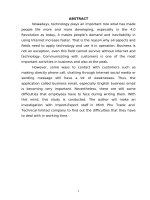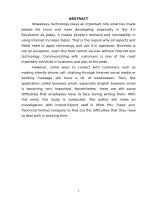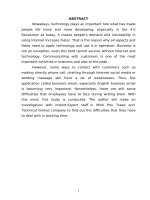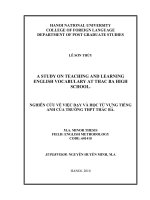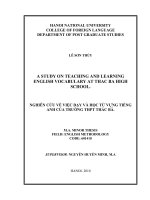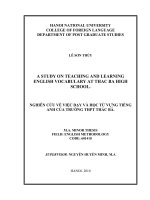Khóa luận tốt nghiệp a study on difficulties in learning english vocabulary
Bạn đang xem bản rút gọn của tài liệu. Xem và tải ngay bản đầy đủ của tài liệu tại đây (1.26 MB, 69 trang )
VIET NAM NATIONAL UNIVERSITY OF AGRICULTURE
FACULTY OF EDUCATION AND FOREIGN LANGUAGES
BA THESIS
A STUDY ON DIFFICULTIES IN LEARNING ENGLISH
VOCABULARY.
NGHIÊN CỨU NHỮNG KHÓ KHĂN TRONG VIỆC
HỌC TỪ VỰNG TIẾNG ANH.
Student
: NGUYỄN THỊ CHI
Student code : 621204
Major
: ENGLISH
Supervisor
: PHẠM THỊ HẠNH, MA
Hanoi - 2021
VIET NAM NATIONAL UNIVERSITY OF AGRICULTURE
FACULTY OF EDUCATION AND FOREIGN LANGUAGES
BA THESIS
A STUDY ON DIFFICULTIES IN LEARNING ENGLISH
VOCABULARY.
NGHIÊN CỨU NHỮNG KHÓ KHĂN TRONG VIỆC
HỌC TỪ VỰNG TIẾNG ANH.
Student
: NGUYỄN THỊ CHI
Student code : 621204
Major
: ENGLISH
Supervisor
: PHẠM THỊ HẠNH, MA
Hanoi - 2021
CERTIFICATE OF ORIGINALITY
I, the undersigned, hereby certify my authority of the study project report entitled
“Study on difficulties in learning English Vocabulary” (submitted in partial
fulfillment of the requirements for the degree of Bachelor in English Language).
Except where the reference is indicated, no other person’s work has been used
without due acknowledgement in the text of the thesis.
Hanoi, 2021
Nguyen Thi Chi
Approved by
SUPERVISOR
(Signature and full name)
Date:……………………
i
TABLE OF CONTENTS
Part 1: INTRODUCTION
Page
1. Rationale for the study
1
2. Aim and objective of the study
2
3. Research questions
2
4. Scope of the study
2
5. Significance of the study
3
6. Design of the study
3
Part 2: DEVELOPMENT
Chapter 1: LITERATURE REVIEW
1.1. Review of previous studies (at home/abroad)
4
1.2. Review of theoretical background
5
1.2.1 Statement of framework chosen
5
1.2.2. Vocabulary’s aspects
5
1.2.3. Vocabulary learning
11
1.2.4. Word structure and formation
13
1.2.5. Semantics
16
1.2.6. Phraseology
17
1.2.7. Etymology
19
1.2.8 Lexicology
22
1.2.9. Difficulties in learning English vocabulary
24
1.3. Summary
29
Chapter 2: METHODOLOGY
2.1. Research governing orientation
30
2.1.1 Research questions
30
ii
2.1.2 Research type
30
2.1.3 Research procedure
30
2.1.4 Criteria for data collection and data analysis
30
2.2. Research method
31
2.2.1. Major methodology
31
2.2.2 Research setting
31
2.2.3 Data collection
31
2.2.3.1 Data collecting instrument
31
2.2.3.2 Data collecting procedure
31
2.2.3.3 Data analysis
31
2.3. Summary
32
Chapter 3: FINDINGS AND DISCUSSION
3.1. Student’s difficulties in learning English vocabulary
33
3.1.1 Student’s English study time
33
3.1.2 Student’s level of English vocabulary
33
3.1.3 Students assessment of the importance of learning English
34
vocabulary
3.1.4 Frequency of students having obstacles in learning English
34
vocabulary
3.1.5 Level of students agreement with common difficulties in
35
learning English vocabulary
3.1.6 Level of students agreement with causes in learning English
36
vocabulary
3.2. Suggestions to help students learn English vocabulary better
38
iii
3.2.1 Level of students agreement with suggestions to learn English
38
vocabulary better
3.3 Discussion about student’s difficulties in learning English
41
vocabulary
3.4 Discussion about useful suggestions to learn English vocabulary
42
3.4.1 Useful suggestions to learn English for teacher
42
3.4.2 Useful suggestions to learn English for students
43
3.5 Summary
46
Part 3: CONCLUSION
1. Recapitulation
47
2. Concluding remarks
48
3. Limitation of the study
48
4. Suggestions for further study
49
REFERENCES
50
APPENDICES
53
iv
ABSTRACT
This study is carried out to figure out difficulties in learning English vocabulary
of students. From those difficulties, some suggestions to help students learn English
vocabulary more effectively have also been given.
In order to accomplish the purpose, 101 English language major freshmen at
Vietnam National University of Agriculture participated. The data collection
instrument is a quantitative research that uses the survey questionnairewith English
language major freshmen about the difficulties faced when learning English
vocabulary. Based on the data obtained, the factors that cause difficulties in students'
learning English vocabulary include pronunciation, spelling, word's grammar and
vocabulary meanings. To be able to improve the above difficulties, some ways are
also given to learn vocabulary better such as: Learning vocabulary through topics,
learning vocabulary by recording in notebook, learning vocabulary by reading
English books, newspaper or magazines and learning vocabulary through English
vocabulary apps.
v
List of charts and tables
Charts
Chart 2.1: Student's English study time
Chart 2.2: Student’s level of English vocabulary
Chart 2.3: Student assessment of the importance of learning English vocabulary
Chart 2.4: Frequency of students having obstacles in learning English vocabulary
Tables
Table 2.1: Level of student’s agreement with common difficulties in learning
English vocabulary
Table 2.2: Level of student’s agreement with common causes in learning English
vocabulary.
Table 2.3: Level of students' agreement with suggestions to help learn English
vocabulary better
vi
PART I: INTRODUCTION
1.1.
RATIONALE
Vocabulary is very crucial for language learning acquisition. It is also an
indispensable unit for learning reading, speaking, writing, and listening skills. By
having rich English vocabulary, students can speak, write, read and listen to English
as they want. Proficiency in English vocabulary can also help students get high scores
in exams since it is one of the compulsory subjects. Nevertheless, many students in
Vietnam still have difficulties learning English vocabulary.
In learning any foreign language, vocabulary is the most significant component.
Language acquisition cannot take place without learning its lexis in various
contextual variables. Vocabulary is one of the most essential parts because it is the
basis for language skills such as listening, speaking, reading, and writing. Without
learning the vocabulary, it is difficult to communicate in the language since it is
central to communicative competence. Low vocabulary knowledge can prevent
learners from communicating effectively. Therefore, without vocabulary, the
learners will be demotivated to use the language.
In reality, in Vietnam, almost all students only study vocabulary in their
textbooks at school as well as through teacher's sources. They have the habit of only
learning new vocabulary in class but they do not often have the habit of reviewing
vocabulary, leading to not being able to remember long and having difficulty in using
words even though they have not been studying for that long. Many of them are not
able to use vocabulary properly in various contexts or pronounce it correctly.
Vocabulary mastery is one of the ways to master a foreign language. The students
have the ability in understanding and using the words and meanings. Not only do
students know the words, but also their meaning. Students can learn vocabulary more
1
easily and understand the meaning of those words. It means that it will cause a big
problem if someone doesn’t have a rich vocabulary. The bigger vocabulary
understudies are, the better they perform their language. By having a constrained
vocabulary, the learners will get difficulties in English abilities.
From the above perspectives, as well as an English language major senior, I
hope to implement this study to find out difficulties in learning English vocabulary
among English language major freshmen at Vietnam National University of
Agriculture. Besides that, this study will also propose some useful English
vocabulary learning methods for them.
1.2 AIM AND OBJECTIVE OF THE STUDY
This study aims to find out difficulties in learning English vocabulary that
English language major freshmen at Vietnam National University of Agriculture
encounter.
After that, some helpful suggestions will be provided to support students
learning English vocabulary more effectively.
1.3 RESEARCH QUESTIONS
This study is accomplished to tackle the following research questions:
- What are the difficulties in learning English vocabulary of English language
major freshmen at Vietnam National University of Agriculture?
- What are the recommendations that help English language major freshmen at
Vietnam National University of Agriculture vocabulary better?
1.4. SCOPE OF THE STUDY
There have been a number of researches on the difficulties in learning English
vocabulary up to now. This study was performed to figure out difficulties in learning
English vocabulary faced by students at Vietnam National University of Agriculture.
Participants are about 101 English language major freshmen at Vietnam National
2
University of Agriculture. The time to conduct research is in the second -term of the
academic year in 2021.
1.5. SIGNIFICANCE OF THE STUDY
The significance of the study points out the difficulties in learning English
vocabulary of English language major freshmen at Vietnam National University of
Agriculture. After pointing out the difficulties, this study gave some
recommendations in vocabulary learning for students.
1.6. DESIGN OF THE STUDY
Apart from abstracts, references & appendices, the study consists of three main
parts:
PART 1 - INTRODUCTION presents rationale of the study, aim and objective
of the study, research questions, the scope as well as the significance of the study.
PART 2 - DEVELOPMENT is divided into 3 chapters:
Chapter 1 - LITERATURE REVIEW – provides theoretical background
for the study including Vocabulary’s aspects; Vocabulary learning; Difficulties
in learning English vocabulary
Chapter 2 – METHODOLOGY describes the methodology used in the research
including: Research methodology; Research setting/context; Data collection
(including Data collecting instruments, Data collecting procedures and Data
analysis).
Chapter 3 - FINDINGS AND DISCUSSIONS - reports and discusses the
findings of the study.
PART 3 - CONCLUSION -summarizes the main issues that have been
addressed in the study.
3
PART II: DEVELOPMENT
Chapter 1 - LITERATURE REVIEW
1.1.
REVIEW OF THE PREVIOUS STUDIES (AT HOME & ABROAD)
Firstly, according Le, T.M (2013) in “Difficulties in learning English
vocabulary faced by the 10th form students at Dong Son I upper secondary school”
presented some difficulties in learning English vocabulary of Dong Son I upper
secondary school students such as ineffective ways of learning vocabulary, lack of
motivation, difficulties related to vocabulary itself, and teacher’s teaching method.
Some solutions were provided by the researcher such as improving awareness of
teacher’s roles, improving vocabulary method teaching and improving students' selfstudy.
Another research, Pham, T.T.H (2010) in “Investing difficulties in learning the
vocabulary of ethnic minority learners at Son La ethnic boarding high school and
some suggested solutions”. In that study, the researcher presented some difficulties
in learning English vocabulary such as lack of general knowledge, lack of motivation,
deficiency of Vietnamese, lack of time, lack of appropriate syllabus for ethnic
minority students, lack of communicative environment, and difficulties caused by
the English difference between the written and spoken form. About solutions, the
researcher also provided some suggestions like using pictures, using word guessing
games, using semantic mapping, using realia, guessing words in context, and
organizing English-speaking clubs.
The study on difficulties in learning English vocabulary was also studied by
Afzal, N. (2019) in “A Study on Vocabulary-Learning Problems Encountered by BA
English Majors at the University Level of Education” of Department of English,
College of Sciences & Humanities at Prince Sattam bin Abdulaziz University. The
researcher also gave several problems in learning English vocabulary such as
4
knowing the meanings of new words, pronunciation, using new words correctly,
memorizing and spelling new vocabulary, and so on. These vocabulary-learning
problems cause the students to feel hard in reading comprehension, writing, and
communication skills due to a lack of vocabulary knowledge.
1.2
REVIEW OF THEORETICAL BACKGROUND
1.2.1 Statement of theoretical framework chosen
This study is performed to find out vocabulary’s aspects, vocabulary learning,
difficulties in learning English vocabulary and useful methods to learn English
vocabulary effectively regarding English language major freshmen at Vietnam
National University of Agriculture.
1.2.2 Vocabulary’s aspects
1.2.2.1 Vocabulary definitions
Vocabulary is defined in different ways. Experts have proposed some
definitions about vocabulary:
According to Neuman, S and Dwyer, J. (2011), confirmed that: Vocabulary is
the terms that someone must know in order to communicate effectively: words in
speaking (expressive vocabulary) and words in learning (receptive vocabulary).
Meanwhile, “Vocabulary is described as all the words that a person knows or
uses while they are talking about particular subjects in a particular language,”
according to Hornby, A. S (2006).
Richards, J and Renandya, W (2002) claimed: Vocabulary is a central
component of language proficiency and provides much of the basis for how learners
listen, say, interpret, and write well. Students listen to words while saying, say words
while reading, interpret words when writing, and use words while learning. Learners
often have difficulty listening to the radio, listening to native speakers, using the
5
language in various ways, reading, or watching tv if they lack a substantial
vocabulary and techniques for learning a new vocabulary.
According to Hiebert, E and Kamil, M. (2005) said that: “Vocabulary can be
learned by accidental learning. Many of a learner's vocabulary can be acquired by
activities rather than specific vocabulary instruction. Repetition, context richness,
and inspiration can all help with the effectiveness of incidental vocabulary learning.”
In view of Thornbury, S. (2002) defines vocabulary as "a list of all the words in
a given language with a shape in a phrase that is synonymous with context." The
overall number of words in a sentence, as well as the words used to convey an idea
or a feeling, are referred to as vocabulary.”
“Vocabulary is a dictionary or a collection of words for a given language,”
Vocabulary is a fundamental part of language and plays a critical role in the teaching
of English”, according to Brown, D. (2001).
1.2.2.2
The concept of “a word”
Definitions: There are many definitions of “a word”
According to David,C. (2003), the following is true: A word is the smallest unit
of grammar that can stand alone as a complete utterance, divided in written language
by spaces and perhaps by gaps in expression.
As mentioned by Hoang, T.T. (1993): “A word is a dialectical unity of form and
content capable of forming a sentence by itself.”
1.2.2.3 Word types:
a) Hyponymy
Definition: As said by Nguyen, H. (2004): “Hyponymy is a relation in which
the referent of one word is fully included in the referent of another word. In other
words, hyponymy refers to the association between hyponyms (the "lower" words)
and their superordinates (the "higher" words).”
6
Example 1: Color
Superordinate
Purple
Blue
Red
.......
Hyponyms
Crimson Violet
Lavender
b) Homonyms
Definition: Homonyms are words that are similar in pronunciation and/or spelling
but with distinct meanings, according to Nguyen, H. (2004).
Classification: Homonyms include homophones and homographs.
+ Homophones are words identical in pronunciation only
*Example: Weak - Week
Sun - Son
Plane - Plain
+ Homographs are words identical in spelling only:
*Example: Fine: good quality OR a levy
Minute: tiny OR unit of time
c) Synonyms
Definition: As opinion of Nguyen, H. (2004), said that: Synonyms are phonetically
and morphologically distinct words belonging to the same part of speech, having
identical denotation but differing in connotation, combination, and so on.
Example: Fast, quick, rapid,.....
Classification:
+ Semantic synonym: are words differing in shades of meaning
*Example: hungry, starving, famished, peckish,...
+ Stylistic synonyms: are words differing in styles of word
7
* Example: mother – mom – mommy - mama, ...
+ Semantic-stylistic synonyms: are words differing both in shades of meaning
and stylistic aspects:
* Example: to dismiss - to shack – to fire - to lay of
House – shack – slum - pad
+ Phraseology synonyms: are words differing in their collocations.
*Example: do - make; start – begin, ...
+ Territorial synonyms: are synonyms that belong to different countries
(territories)
*Example:
In England
In America
In Australia
Autumn
Fall
Autumn
Luggage
Baggage
Baggage
Football
Soccer
Soccer
Sandals/Flip-
Sandals/Flip-Flops
Thongs
Gas station
Petrol station
Flops
Petrol
station
services
d) Antonyms
Definition: According to Nguyen, H. (2004), said that: “Antonyms are words of
opposite meaning and of the same part of speech.”
Example: long – short
tidy – untidy
8
Usually adjectives denoting qualities, verbs denoting actions or state and
abstract nouns have antonyms:
Example: old – young
give-take
Concrete nouns have no antonyms:
Example: book, window, fan, curtain, ....
Antonyms are sometimes used for stylistic purposes:
Example: It was the best of times – It was the worst of times
It was the age of wisdom – It was the age of foolishness
Classification:
+ Root – word antonyms: are words totally distinctive in sound –forms.
* Example: good - bad
peace - war
+ Derivational antonyms: are words shaped by adding affixation to root words.
* Example: Like – dislike
Useful –useless
e) Polysemy
Definition: Nguyen, H. (2004) presented: “Polysemy is a relation in which a single
word has two or more slightly different but closely related meanings.”
Example: The word “face” in:
+ She washes face every morning. ( Face is part of the body )
+ She faced the punishment for being late. ( Face is deal with something
unpleasant)
Classification:
- The criteria utilized to recognize between homonymy and polysemy are
9
+ Meaning
+ Etymology
f) Simple word
Definition: According to Howard. J and Etienne, Z.A. (2007) said that “A simple
word is the basic word form with nothing added to it.”
Example boy, girl, tall, small, blue, green,...
Classification:
+ Simple nouns: tree, flag, song, comb,.....
+ Simple adjectives: good, bad, narrow, wide,...
+ Simple verbs: go, run, walk, climb,...
g) Derived word
Definition: According to Howard. J and Etienne, Z.A. (2007) stated that: “A derived
word is one that only consists of a root morpheme and one or more derivational
morphemes.”
Example : Teach -Teacher
Love -Lovely
Classification
+ Derived nouns : kill - killer, teach - teacher, act – actor,..
+ Derived adjectives: good – better –best, bad – worse –worst,..
+ Derived verbs: come - upcoming, go -undergoes,...
+ Derived adverbs: love - lovely, happy – happily,..
h) Compound word
Definition: According to Howard. J and Etienne, Z.A. (2007) claimed that: “A
compound word is one that has at least two roots without derivational morphemes.”
Example: bookstore, notebook, fireman,...
Classification
10
+ Compound nouns: door –handle, lady – killer,...
+ Compound adjectives: hot – tempered, easy –going,..
+ Compound verbs: whitewash, team –teach
+ Compound adverbs: whole – heartedly, self – confidendently,...
+ Compound prepositions: onto, into,..
1.2.3.Vocabulary learning
1.2.3.1 Word-meaning
a) Definition:
On the basis of Hurford, J. and Heasley, B. (1984) confirmed that: Language
sense is what a word does, what qualifies as the equivalent of the language in
question.
b) Types of meaning:
In view of Hurford, J and Heasley, B. (1984) claimed that there are two types
of word meaning: primary meaning and secondary meaning.
The primary meaning is the first meaning or usage that the word will suggest
to most people when it is said in isolation.
Example: “wing” is the thing which is used to fly by a bird
Secondary meaning of a word is context bound whereas its primary meaning is
not.
Example: He often plays on the wing: “Wing” means ‘side part of the playing
area in football, hockey,..”
According to Lyons,J. (1995): “Word meaning has two types of meaning are
literal meaning and figurative meaning”
+ Literal meaning is the basis or usual meaning of a word.
For example: Here are some literal meanings of word “ wing”
*) Part of a bird's or insect's body (wings of dove)
11
**) A component of an aircraft that aids in its flight (the two wings of airplane)
***) Above the well, a portion of the vehicle's body (the left of wing of the car
was damaged in the collosistion)
+ A word's figurative sense differs from its literal meaning, and it conjures up
colorful mental memories in the minds of readers or listeners.
For example: Here are some figurative meaning of word “wing”
*) To extend activities and interests of someone:
Her parents hope life abroad will help her to spread her wings a bit.
**) To prevent someone from something:
Having new troubles to get over has clipped his wings a bit.
***) Under someone's protection or care:
She always put her children under her wing.
c) Components of word- meaning
Howard, J and Etienne, Z.A. (2007) identified two types of word meaning:
denotational and connotational. In which, he said as following:
The denotational meaning signifies or points out objects, concepts,...” Example:
“dolphin” denotes an animal that can swim or “mother, mom, mommy’ indicates the
female parent.
The connocational meaning demonstrates how things, thoughts, and ideas are
indicated. It expresses the speaker's mood, feelings, and so on. The personal part of
meaning, the emotional connections that a word evokes, is referred to as connotation.
Individual experiences shape connotations, yet because humans have common
experiences, certain words have shared meanings.”
Example: Dove: is peace, change and freedom.
As mentioned by Fauconnier,M. (1985), components of word-meaning include:
Direct meaning and indirect meaning. In which, he showed:
12
Direct meaning is a meaning that expresses something without comparing it to
other things or relating it with others.
Indirect meaning refers to a meaning that conveys anything only inferentially.
To comprehend it, we must compare it to something else or identify it with something
else.
Example: The word “pen” in:
Example 1: He has a pen.
Example 2: He is the best pen in Viet Nam.
( “pen” in Example 1: indicate something to write, but “pen” in example 2
indicates a writer.)
1.2.4 Word structure and formation.
1.2.4.1 Word structure
a) The morpheme
Definitions: It is defined in different ways:
Concurring with Hoang, T.T (1993), said that: “A morpheme is the smallest
critical unit of a word that's as a part of a word.”
Example: teacher has morphemes are teach + -er
unlucky has morphemes are un + -luck + -y.
b) The types of morpheme
There are two types of morphemes: the root morpheme and the affixational
morpheme.
The root morpheme is called the essential component of the word and possesses
its basic word meaning.
Example: “teacher” has root morpheme is teach
The affixational morpheme is isolated into grammatical morpheme and
derivational morpheme:
13
The grammatical morpheme is also called the inflection about grammar of
words. It is utilized to make diverse shapes of the same word that carries the syntactic
meaning.
Example: - s in ‘cars’ or – ed in “expected”
The derivational morphemes are used to make new words. New words are
created by adding affixation.
Example: use – useful –useless – uselessly.
1.2.4.2 Word formation
Definition: In view of Finegan, E. (1994): “Word-formation is the process of
building new words from the material already existing in the language according to
certain and semantic patterns and formulate.”
Word formation usually uses affixation. Affixation is divided into prefixation
or suffixation.
a) Prefixation
Classifications: In common, prefixes in English have three meanings: negative
meaning, inversion or reiteration of an activity, space and time relationship.
Example:
Prefixes
Meaning
Un-, dis-, non-, -,il,
Negation
-ir-,im-, ,...
Un- dis, -re,...
Examples
Unhappy, dishonest, nonsense,
illegal, irregular, impossible,...
Reversal or
Unlock, disconnect, rewrite,
repetition
retell, redo, regain
Pre-, post-, fore-,
space and time
Postwar, foresee, oversleep,
over-,...
relationship
....
14
b) Suffixation
Classification: In English, suffixes fall into the following groups:
+ Noun-suffixes: -or,-er, -tion, -ness,...
+ Adjective- suffixes: -al, -able,-less, -ful, -ish,...
+ Verb-suffixes: -ise, -fy,,..
+ Adverb-suffixes: -ly, -ward, -wise,..
- Here are some suffixes is summarized by table:
Type
Suffix
Meaning
Examples
Adjective-
-able,-ible
Denoting quality or
Movable, drinkable,
ability
visible,..
Denoting somewhat
Whitish, outlandish,
like, belong to,
wolfish,...
-less
resembling,...
Careless, useless,..
Verb-
-ize
Denoting action
Organize, realize, ...
suffixes
-fy
Denoting naming
Beautify, signify,..
-en
action
Redden, shorten
suffixes
-ish
Denoting action
Adverb-
-ly
suffixes
Denoting manner of
Carefully, hopely, ...
action
-ward
-wise
Denoting direction of,
Southwards, forward,
manner of action
afterward,...
Denoting manner of
action
Salewise, otherwise
15
1.2.4.3 Other types of word-formation
Shortening: According to Hoang, T.T (1993) , defined: “ Shortening is the
word-formation process which consists of the reduction of a word to one of its parts.”
Example: exam(imation); math(ematics),...
Abbreviation: According to Hoang, T.T (1993), stated: “Acronyms are words
built from the initials of several words:
Example: BBC (British Broadcasting Corporation); VOA (Voice of America);
UNESCO (United Nations Educational, Scientific and Cultural Organization),...
Clipping:
Initial clipping: (mobile)phone; (air)plane,..
Final clipping: lab(oratory); sis(ter); bro(ther); uni(versity);...
Intio – final clipping: )Re)fridge(rator)
Medical clipping: V(victory)- day,...
Elliptico-conversational: pop (popular music); pub (publishing house); perm
(permanent);...
1.2.5 Semantics
1.2.5.1 Definition:
By opinion of Richard,J. (1987), defined “ Semantic features are the smallest
units of meaning in a word.”
Example: “mother” may have the following semantic features: [+human],
[female], [matured], [parental].
1.2.5.2 Semantic fields:
Definitions:
Richard, J. (1987) defined “ A semantic field is the organization of related
words and expressions into a system which shows their relationship to one another.”
16
According to Crow, J and Quigley, J. (1985), gave definition of semantic fields:
“Every word in our lexicon has a precise meaning that we recognize right away when
we see it. Some of the terms are more semantically connected to one another than
others, in the sense that when we hear one, we automatically think of the other.When
we hear the word teacher, we may think of school or student. When we hear the word
door, we may think of window or wall. These basic examples demonstrate that these
words belong to distinct categories, which we can all perceive. The term "semantic
field" refers to the interaction between the words.”
Example 1: The semantic field of school terms: teacher, students, subjects,...
Example 2: The semantic field of adjectives describing human emotional states:
excited, angry, depressed, afraid,...
1.2.6 Phraseology
1.2.6.1 Definitions:
According to Hoang, T.T. (2003) “Phraseology is the study of fixed expressions
such as (to be) in high feather; (to be) as hungry as a hunter; good heaven,...”
Gledhill, C. (2000) also mentioned: “Phraseology comprises set expressions
that may be wholly or partially fixed. To put it another way, they are either immutable
or changeable expressions.”
In terms of definition, Cowie, A and Howarth, P. (1996) also said that
“Phraseology can be loosely defined as the study of conventional phrases, where
'phrase' means any multi-word expression up to sentence level.”
1.2.6.2 Phraseology features
a) Structural features:
As mentioned by Hoang, T.T. (1993): “Phraseological includes set expressions
that may be completely or partially fixed. In other words, they are either nonchangeable or changeable expressions.”
17


